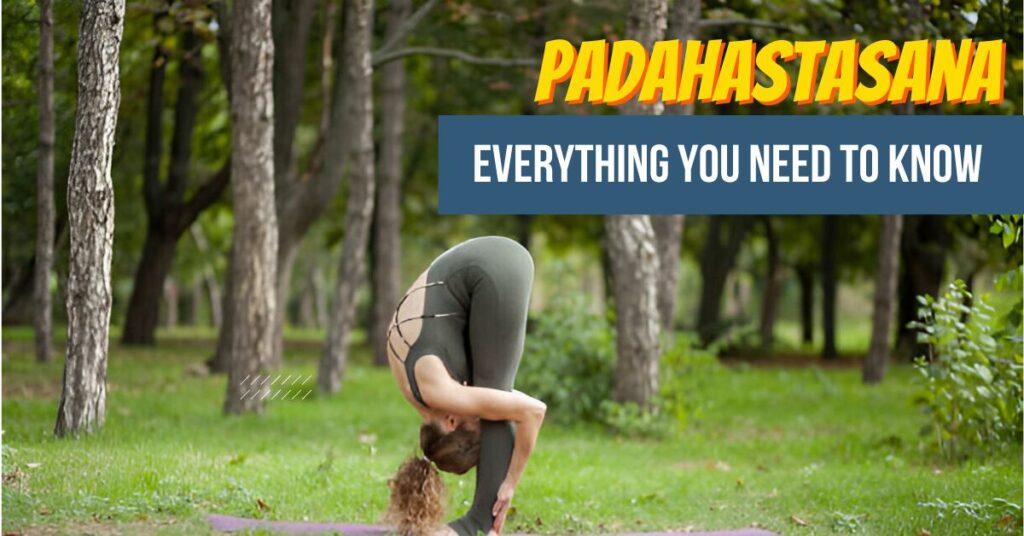It has become an essential aspect in today’s world to stay relaxed and healthy. For many individuals, yoga has always been an option as it keeps the body strong and calms the mind. One of the best poses among all that is especially good is called Padahastasana. This asana is not just about trying to touch your toes; it’s all about how you make your body more flexible and robust and allow your mind to focus. In the blog post below, we are going to discuss what is Padahastasana, how to do this yoga asan, what are Padahastasana benefits and we will also share some great ideas to avoid getting hurt.
Whether you have been doing yoga for a long time or just thinking of getting started, this will help you learn a pose that can help you feel better. Let’s dive deep into the world of Padahastasana together and find a simple way to live a healthier and happier life.
What is Padahastasana?
Padahastasana, often referred to as Uttanasana or Hand-to-Foot Pose, is performed during Surya Namaskar or Sun Salutation. This is the foundational asana in Yoga that stretches various parts of the body, including your calves and hamstrings. Along with that, it tones and massages the digestive organs while offering mental clarity and releasing stress.
In Sanskrit, Pada means Foot, and Hasta means Hand; hence, the Padahastasana pose is a pose where you try to touch or hold your feet with your hands while standing and bending forward. This asana is good for stretching your back, legs, and arms. For anyone who is starting yoga or looking to add this asana to their routine, this asana will help you make your body more flexible and your mind more peaceful. It is helpful in releasing excess Vata (air) from your abdomen while improving blood circulation. This asana should not be performed by people with high blood pressure, hernia, back injuries, sciatica, or heart disease and pregnant women should also avoid performing this asana.
Benefits of Padahastasana
Padahastasana is a fundamental yoga pose that has numerous benefits for the mind and the body. Let’s discuss what are the benefits of Padahastasana in detail:
- Performing Padahastasana yoga regularly can help make your back muscles and spine stronger, which can help you improve your posture and reduce back pain.
- It stretches the hamstrings, hips, and calves, improving overall flexibility, especially if you sit a lot during the day.
- This yoga asan massages and stimulates the internal organs. This helps in digestion and makes your organs, like your liver and kidneys, work better.
- Padahastasana steps help you to calm your brain and help your skin to glow. The inverted nature of the pose lets the fresh blood flow to the brain.
- This asana also strengthens and tones the body, leaving you feeling balanced and flexible.
- If you perform this asana regularly, it can help you cut down the extra fat from your body and keep your heart healthier.
- This yoga helps you take over symptoms like laziness, stress, anxiety, mild depression, demotivation, heaviness etc. and keeps you energized.
- This asana can also help you to prevent thyroid symptoms, keeping you healthy.
- It also helps during the female menstrual cycle.
How to do Padahastasana? (Detailed Steps)
Padahastasana, also known as the Hand Under Foot Pose, is a standing forward bend (similar to Paschimottanasana but in a standing way) that offers many health benefits. Here’s a detailed steps of Padahastasana:
Step 1: Before beginning the procedure of Padahastasana, stand tall (in Tadasana Pose). Make sure to keep your feet together, breathe deeply, and find your balance and focus.
Step 2: Inhale and lift your arms towards the sky. Lengthen yourself as much as you can.
Step 3: Now, while breathing out, slowly bend from your hip level so you reach forward, keeping your back completely straight and go down towards the floor when your palms can touch the floor. Make sure your head and arms go down together, and your knees are straight.
Step 4: Keep your head close to the knees and both palms beside your feet. Please note that in some cases, as you go down the floor, you insert your palms under your feet, with your palms upwards and your toes touching your wrist. Lift your head and look forward. This can be achieved with the regular practice of Padahastasana steps. Also, in some other cases, you hold your calves with your hands.
Step 5: Remember, if you have a problem with stiffness in your back, then bend only up to the point where you don’t experience any strain or difficulty. You can also use the support of a wall or a chair.
Step 6: Breathe deeply and hold this position for a few breaths (up to a minute).
Step 7: In order to release the pose, take your hands from under your feet and bring your palms to your hips. Press your feet into the floor, and with a straight back, slowly come back up to Tadasana or standing.
Common Mistakes while Performing Padahastasana
Now that you know the Padahastasana steps and benefits, it becomes essential to understand the common mistakes to avoid any injuries while doing the Padahastasana procedure. Let’s dive deep into this:
- The first and foremost mistake is “Rounding Your Back”. This happens when you are not very flexible, and you try to go too deep into this asana. If you can’t reach down, you can keep a micro-bend in the knees.
- Please don’t hold your breath while doing Padahastasana yoga, as it can create tension in the body. This will make the pose even more challenging to do.
- If you push too hard into the pose, it can lead to overstretching and injury. Listen to your body, and don’t push over the limits.
It is not about how perfect the yoga asana looks but how connected you are to your body and breath.
Contraindications of Padahastasana Yoga Pose
While Padahastasana benefits are numerous, it should still be avoided by certain people due to their health concerns and conditions. Here are some Padahastasana contraindications to keep in mind:
- People with recent or severe back injuries should avoid performing the steps of Padahastasana.
- If you are suffering from an abdominal hernia, you are strictly not advised to do this asana since the abdominal pressure while performing this pose might worsen the condition.
- Those who have high blood pressure and glaucoma should be cautious or better avoid the pose, as when you keep your head below the heart, the blood pressure levels may increase and cause issues.
- Individuals with heart conditions should avoid doing this asana.
- Pregnant Women should avoid doing this yogasana, especially in their second and third trimesters.
- Anyone with osteoporosis or low bone density may need to be cautious with forward bends as it can cause strain on the spine.
Conclusion
Padahastasana is a fantastic yoga pose that helps your body and mind in many ways. It is essential to perform this asana with the proper alignment, making sure you do not hurt yourself. This pose can help with digestion, make you feel less stressed, and strengthen your back and legs. However, always remember that each individual is different and does not possess the same qualities. So, always listen to your body, and don’t go too deep into the asana. Adding this asana to your daily routine can make you feel better. Yoga is a personal journey, and this pose is a good step for you, which can help you feel more in tune with yourself.
Frequently Answered Questions (FAQs)
Who should avoid Padahastasana?
Padahastasana procedure should not be performed by individuals who have back problems, heart diseases, sciatic, high blood pressure issues, or abdominal hernia. Also, pregnant women should avoid performing this asana.
Who should do Padahastasana?
Anyone who wants to keep their body and mind healthy can do this yoga asana. Padahastasana pose helps you calm your mind, maintain focus and enhance your abdominal muscle strength. Regular practice of this asana can help you improve the overall flexibility of the body.
What are the benefits of Padahastasana?
There are many benefits of Padahastasana, some of them are:
- It stretches and strengthens back and leg muscles.
- Improves flexibility and posture
- It stimulates the digestive system (eases issues like constipation and digestion)
- Enhance blood circulations
- Calms the mind and reduces stress, anxiety & depression.


